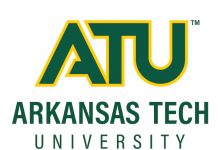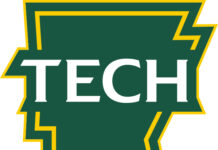One of the most significant artifacts related to Arkansas Tech University athletics ever discovered will be available for public viewing for the first time during Homecoming 2015.
The personal playbook of John E. Tucker, the Original Wonder Boy, from his days as head football coach at Arkansas Tech will be part of a new exhibit that will open in the Arkansas Tech Museum this weekend.
The museum, located in the Techionery at 1502 North El Paso Ave., will be open from 8 a.m.-5 p.m. on Friday, Oct. 9, and 10 a.m.-2 p.m. on Saturday, Oct. 10. Admission is free and open to the public.
The playbook is in Tucker’s handwriting on the back of a 1937-38 school activities calendar. Paul Smith, director of athletic communications at Arkansas Tech, found the playbook during the spring 2015 semester. It was rolled up in a mailing tube and hidden behind a portrait of Tucker inside the trophy case at Tucker Coliseum.
Smith passed the item along to the Arkansas Tech Museum, where director Judith Stewart-Abernathy and her staff took the appropriate steps to verify its relationship to Tucker, preserve it and prepare it for display.
Tucker played football at Arkansas Tech from 1919-24 and accumulated an insurmountable school-record total of 443 career points scored. No other Tech player has ever scored more than 259 career points. All-America running back Eddie Meador amassed that figure from 1955-58.
From 1920-24, Tucker led the Wonder Boys to a cumulative record of 31-3-5. Their only three losses during that span were to the University of Tulsa (1922), Army (1923) and Texas A&M (1924).
Henry Loesch, sports editor for the Arkansas Gazette, wrote the following in describing Tucker’s performance in a 14-7 win over Little Rock College on Nov. 5, 1920.
“Now for the rest of the story that Russellville asked for; for the introduction of a super player and for the details of his performance,” wrote Loesch. “Russellville knows who we mean, by sections the rest of Arkansas is being acquainted with him — fans, friends and the Ouachita Tigers, if you ever meet the Russellville Farmers look out for Capt. John Tucker. Look out for him before he starts, for once he is on his way brick buildings, rock walls and other immovable bodies but slightly impede his progress.
“The husky captain, he weighs a neat 180, did not have a corner on the Russellville punch and he did not play the game alone, there are other men in the Aggie backfield who smash with terrific force and who are equal to the role of individual star, but this Tucker is so good that he makes the rest of them look bad,” continued Loesch. “He’s so good that it is hard to see any one else on the entire field.”
It proved to be one of Tech’s final games under the Aggies moniker. Little more than a week later, the Arkansas Gazette used Wonder Boys as a proper noun for the first time following a 13-0 win over what is now Henderson State University. The nickname has been part of Arkansas Tech lore ever since.
The end of Tucker’s playing career was merely the beginning of his service to Arkansas Tech. He went on to work at the school in a variety of roles — including coach, teacher, athletic director and director of student affairs — between 1925 and 1972.
Tucker took a brief sabbatical from Tech to attend the University of Alabama, where he played on the Crimson Tide team that defeated Washington State 24-0 in the 1931 Rose Bowl.
He came back to serve as head coach for the Wonder Boys football team from 1933-41 and again from 1945-47. He won 77 games and five Arkansas Intercollegiate Conference championships as Tech head football coach. His .791 winning percentage still stands as the best of any head football coach in school history.
Today, two buildings on the Arkansas Tech campus — Tucker Hall and Tucker Coliseum — are named in his honor. He entered the Arkansas Sports Hall of Fame in 1962 and he was part of the first class inducted into the Arkansas Tech Hall of Distinction in 1965.
The new exhibit at the Arkansas Tech Museum includes Tucker’s plaques from the Arkansas Sports Hall of Fame and the Arkansas Tech Hall of Distinction. Other items include his diploma from the Second District Agricultural School (the original name of Arkansas Tech University) and his Master of Science degree from the University of Alabama, as well as a number of photographs and a timeline of his life.
Visit www.atu.edu/museum to learn more about the Arkansas Tech Museum.





